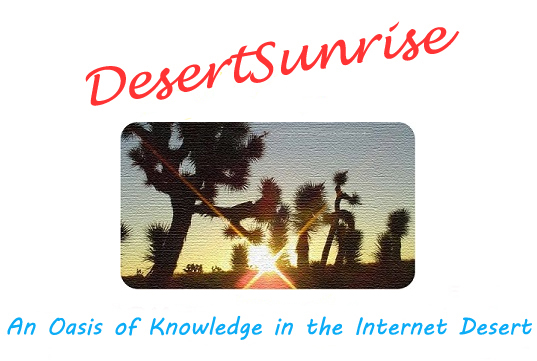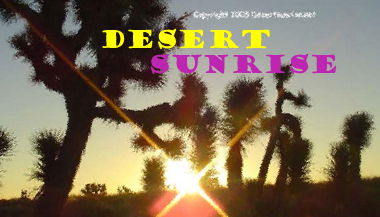

Location:
The United States of America
Water or H2O = 2 atoms of Hydrogen and 1 atom of Oxygen and without that compound ALL life would cease to exist! On Earth that is, life on Vulcan may not need water but just logic!
Western Water
In the Western United States, water, water rights, water use and abuse has been an issue of great concern from the days of the first European explorers right up until today. Most of the continental western states are arid except for the western portions of Washington - Oregon and the North West of California.
In the arid desert areas of the West a new war is being fought, over water! Battle lines are been drawn, forces massed and troops trained. But so far this war has not seen the US Calvary destroy what is left of the Native American Tribes nor is it a war against an external aggressor. But rather it is a war "against excessive internal consumption". The principle characters in this conflict are lawyers, farmers, ranchers, water agencies, water consumers, land developers and the media.
Due to the mass media's ability to control and manipulate most of the information available to the general public, except for the internet, the grave water shortage has not garnered much attention. The average consumer just wants to know if he/she turns on the tap will water flow! Unfortunately far too much of our news and information comes from a few small "politically correct sources". Again, except for the internet, scant information is made available to the public concerning the gross water waste most of us commit every day.
Now the Western desert regions are blooming through out all 4 seasons, but we are not speaking of Sage and Mesquite but new housing developments, apartment buildings, strip malls, and storage centers. And to connect all of this together we have new roads with lots and lots of new vehicles on the roads and in our driveways, garages, drive through car washes etc. This type of suburban development is very typical of Southern California where the term "transportation" equates to automobiles and virtually nothing else.
And in our new houses we all want all the same luxuries we enjoyed in Los Angeles, Seattle, Miami, St Louis, New York, Chicago, London, Bonn, Berlin, Tokyo, Manila, Bombay, Mexico City. But most of the immigrants and even the established residents have been fed a false idea of desert living thanks to a individual named William Mulholland (September 11, 1855 – July 22, 1935). Real estate agents, housing developers, banking institutions, and the construction industries have all kept the Mulholland lie alive!
So with the increased population the desert area municipalities are drilling ever deeper and more water wells. And now the water quality is decreasing, the cost of water is rising and the ground is subsiding along with other environmental problems. And it seems as if the popular mass media has gone PC again buy supporting this belief that our desert lifestyles will be no different from the lush green landscapes of the well watered Eastern & Northern states. This political correctness of the mass media (television - newsprint - radio - periodicals) seems to have infected both sides of the political spectrum. Money talks!
What is extremely important for all of us to understand is that at any moment a group such as the ACLU, Sierra Club or even PETA could possibly bring a lawsuit against the citizens and municipalities of the Antelope Valley (a booming northern suburb of Los Angeles) for say excessive ground water pumping. This could put the Antelope Valley area in a similar situation as say Las Vegas. (See Below) This is because the Antelope Valley is already pumping too much water out of the ground table and it is negatively affecting the landscape and also water quality (The Water Quality has become so notorious that the wife of the DesertSunrise webmaster forced him to purchase a unique water softening system). Ground subsidence is evident. Native plants and trees die without surface watering. Natural streams and ponds that might have been available for watering animals in the past are now permanently dry year round. Remember this valley received it's name due to Antelope herds that once roamed the valley.
Just think of how much water we use daily. You probably do not realize how much water we use and how much we actually waste, I didn't. The following information should give you a better understanding of just how much water we use and waste on a yearly basis. These figures are NOT for a particular state or city but for the general US population as a whole. What the information shows is that really significant water savings can be made especially in the desert states of the West.
The following information is from the American Water Works Association:
Average US Annual Water Use.
Data use period is from 1996 - 1999
American households used approximately 146,000 gallons of water annually during this time period (1996-1999), and I see no reason why this figure would be any less today. Of this amount 42% (61,300) was used indoors. The remaining 58% (84,700) gallons was used outside of the home.
In households not using water-efficient fixtures, toilets used the most water on a daily basis - 20.1 gallons-per-day. Clothes washers were second using 15 gallons-per-day. Showers came in 3rd, using 13.3 gallons-per-day per person.
In households using water-efficient fixtures some numbers and volumes change significantly and some don't. Clothes washers come in 1st at 15 gallons-per-day, no change. Faucets were second at 10.9 gallons-per-day. 3rd were showers at 10 gallons-per-day. In at 4th were toilets at 9.6 gallons-per-day.
Both showers and toilets had a significant change showers showed a 3.3 gallons-per-day drop and toilets a good 10.5 gallons-per-day drop.
Also noted was that the presence of teenagers increased significantly the water use patterns. The presence of full-time working adults decreased water use.
What all those numbers add up to is with each new house built in the Antelope Valley we must pump an additional 146,000 gallons of water, or try and buy water from the State Water Project (California Aqueduct). The problem (see Problem) is that the desert usually is not capable of supporting a large population with or without commerce and industry present. The population pressures (see Population Pressure Cooker)of the USA as a whole and in this case particularly southern California are experiencing a suburban sprawl into the desert regions. The same habits, ideas and views of a non-native population only worsens the water problem along with pollution and a general misunderstanding of the fact that a desert is NOT a wasteland. But our stupidity can and will and is at present making our deserts into a wasteland. The average house in the Antelope Valley probably wastes 50% of the water that is used for landscaping. The next time you take a walk, bike ride or drive through the Antelope Valley cities take a visual note of how much water you see rushing down the gutters into our storm drains when residents are watering their lawns! Desert type landscaping should be the norm not the "artificial green heaven" that developers promote.
Perceptions Must Change
Our perception of the desert must change! Listen to this. While speaking with a few of the neighbors about some possible changes to a more desert like landscaping I was planning to make, and the hackles immediately went up on most of those I spoke with. The neighbors did not relish the thought that a house on the block might not have anything less than "Tarzan's Jungle Green Landscaping". The unspoken thoughts were "property values will drop" "it will be an eyesore" and the killer "it will look like we are living in the desert"! You can stop laughing now.
I can only look aghast at people who make such illiterate statements like "the desert is full of sagebrush and it's best to leave it in the desert". For the love of God people, WE are in a desert. It is these perceptions that are holding us back from changing our lifestyles to reflect the environment we live in.
In the Antelope Valley of California we can see a desert area being transformed from a rural ranching & farming valley into a urban housing & commercial valley. Honestly there are probably not many methods available to stop the influx of people into this valley, but with education, training and with a community aware of it's responsibilities to it's surrounding environment, the impending disaster can possibly be avoided. But the new urban settlers to the desert must have a conscience rooted not in the blind urban apathy, but in visual rural awareness.
What that means is that all of this valley's residents (old & new ) need to see this valley as it once was (visually through old photo's and drawings) and visually see the impact WE are having on the surrounding environment. The desert is not a dumping ground for used car parts, derelict vehicles, irrigation pipes, construction debris, nor is it a vast off-road vehicle playground! A tread lightly concept must permeate throughout the valley's residents not through a government $$$$ program but through the area's commercial concerns, churches, clubs and schools.
Water is the life blood of this valley (Antelope Valley) as with so many other desert communities throughout the West.
Problem
This information below is provided by the US Geological Survey at http://ca.water.usgs.gov/projects00/ca532.html
Antelope Valley is located in the western part of the Mojave Desert, about 50 mi northeast of Los Angeles, California. The valley is a triangular- shaped, topographically closed basin covering about 2,200 square miles. Ground water is an important component of water supply in Antelope Valley, comprising about 50 percent in years with normal precipitation and as much as 90 percent in dry years (Templin and others, 1995). Estimates of average annual ground- water recharge range from about 40,000-58,000 ac-ft. (Snyder, 1955; Bloyd, 1967; Durbin, 1978). Pumping in the valley, primarily for agricultural uses, peaked in the 1950's when production may have exceeded 400,000 ac-ft. annually (Snyder, 1955). Increased pumping costs from greater pumping lifts and increased electric power costs resulted in a decrease in agricultural pumping in the 1960's and 1970's. Increased urban growth in the 1980's resulted in an increase in the demand for water and an increase in ground-water use. Ground- water-level declines as a result of the long-term ground-water withdrawals have increased pumping lifts, reduced well efficiency, and caused land subsidence (Ikehara and Phillips, 1994).
Projected urban growth and limits on the available local and imported surface water supply are likely to continue to increase the reliance on ground water. Projections of water supply and demand estimate that the current supply will fall short of the projected demand by the year 2000 (Kennedy/Jenks, 1995). A deliberate management effort will be required to meet future water demand in the Antelope Valley without incurring significant economic and environmental costs associated with overuse of the ground-water resource. Conjunctive use of surface and ground-water will likely become an important part of water resource management in Antelope Valley. The ground-water system is the least understood component of Antelope Valley water resources. To effectively manage the ground-water resource, there is a need to evaluate and understand the geo-hydrologic characteristics of the ground-water system. This understanding can lead to the development of tools that can be used to make informed management decisions.
Las Vegas's Water Shortage
Severe water shortage! I really do not believe that the residents of the Antelope Valley or for that matter any city or municipality in the desert west wants to end up like Las Vegas circa (8/15/05). The continual explosive growth and unabated water waster along with contamination of the available due to various factors could see the Antelope Valley in a similar situation in the near future.
The city of Las Vegas and other towns in the Southern Nevada are in the Drought Alert stage of a 3 stage system. I have listed below a sample of some of the restrictions enforced by the authorities. Just image how much more these restrictive these Las Vegas area water regulations will be in the future if their drought continues along with an exploding population! At present the SNWA (Southern Nevada Water Authority) is in a Drought Alert condition. The next level would be a Drought Critical condition. The 3 levels are:
1. Drought Watch
2. Drought Alert
3. Drought Critical
Can we avoid the Antelope Valley in the same predicament as Las Vegas? Are we as a community destined to see the desert become a wasteland? See some actual answers.
SNWA Water Regulations
Landscape Watering
Watering:
Same provisions apply as during Drought Watch except Sunday is no longer an optional watering day in spring and fall.
Grass Planting & Reseeding:
Planting cool-season turf is prohibited May through August. Includes bentgrass, bluegrass, fescue and ryegrass. Includes existing landscapes and all planting methods.
Fountains & Water Features
Residential Use:
Fountains and water features of less than 25 square feet surface area are allowed at a single-family residence.
Commercial Use:
Prohibited. Exemptions noted below.
Vehicle Washing
Washing of personal vehicles on residential properties is limited to once per week per vehicle and requires a positive shut-off nozzle on hose. There is no limitation on washing frequency if using the guidelines for commercial vehicles or using a high-pressure, low-volume sprayer.
Commercial vehicle washing prohibited except where water is captured to a sanitary sewer through approved methods or except where using a high-pressure, low-volume sprayer using less than 10 gallons per vehicles.
Mobile car washing is allowed as long as company uses high-pressure, low-volume sprayer and uses less than 10 gallons of water per vehicle.
This is not a complete list nor are the small table below complete, all this is just to give the Antelope Valley residents a taste of what might come our way in the near future.
|
SNWA recommended water waste fees
|
|||||
| Meter Size |
First Violation |
Second Violation |
Third Violation |
Fourth Violation |
Fifth Violation |
| 1 inch and less | $40 | $80 | $160 | $320 | $640 |
| Over 1" but less than 3" | $80 | $160 | $320 | $640 | $1,280 |
| 3" or larger | $160 | $320 | $640 | $1,280 | $2,560 |
Southern Nevada's consumptive water use declined about 18 billion gallons between 2002 and 2004, despite the fact that there were approximately 165,000 new residents and 37 million annual visitors.
Some Actual Answers
In the high desert regions of the West, when Winter comes let your lawn go fallow. This is a natural event and does not mean your lawn is dead! Not only does this save on water use it also means less fertilizer use to keep your lawn green all year.
Plant native or drought-tolerant grasses rather then grass types native to the East or South. Keep your lawn mower set cut to about 3" level. Higher grass encourages grass roots to grow deeper and this in turn also shades the root system. Leave your grass clipping on the lawn as this will reduce the need to fertilize.
Remember also that over watering coupled with heavy fertilizer use usually sends a torrent of runoff water down the sidewalk into the gutter and then draining into the storm basins and then seeping into our water table.
Use drip irrigation systems and or soaker hoses. A simple solution of slowing dripping water onto shrubs and plants rather then flooding which causes excessive evaporation. This will also benefit buildings, wood fences, brick walls and other structures from water damage & salt deposits.
Use Xeriscape. xeros means dry in Greek, so xeriscape just mean dry landscaping.
Ocotillo ,Green Cloud Sage, Soaptree Yucca, Red Oleander, Spanish Broom, Red Leaf Photinia, Agave, Bowles Mauve, Chaparral Save would all be excellent plants for xeriscaping.
 Xeriscape
and the Xeriscape logo are NOT trademarks of the Denver Water
Department. This is a correction as I originally understood the Denver Water Dept. had created and owned the rights. Further research as
proven this to be correct.
Xeriscape
and the Xeriscape logo are NOT trademarks of the Denver Water
Department. This is a correction as I originally understood the Denver Water Dept. had created and owned the rights. Further research as
proven this to be correct.The term Xeriscape was created by the Front Range Xeriscape Task Force of Denver Department in 1978.
Use potted plants. The Spanish have done for centuries. And also hydrozone, or group your plants based on their water needs so as not to over water some plants that might be planted next to a plant that needs less water. But using potted plants and shrubs is still the better water saving method.
For all plants and shrubs instead of fertilizing, try a natural alternative such as plant compost. If you must apply fertilizer due to soil conditions, try and use one that contains slow-release, water-insoluble type of nitrogen.
Do business with car washes that recycle their water. Their is no need to wash your vehicle every week and try using devices like the California Car Duster. Clean your driveway with a broom not the hose.
The USA uses about 1.2 trillion litters of water annually or about 317 billion gallons of water for about 3 billion professional washes and 2.25 billion home washes. That comes out to approximately 60 gallons per wash.
Greywater - Graywater - Gray Water - Grey Water?
However you want to spell it, greywater is any water that has been used in the home, but not water from toilets, is called greywater. This can dishwater, shower water, sink, and laundry wash water comprise about 50-80% of residential "waste" water. This can be reused for other purposes, but usually its used for landscape irrigation.
A simple search with Google using the terms ( xeriscape - drip irrigation - soaker hoses - compost - car duster - hydrozone ) should lead you to many ways in which to not only help our environment, keep the eco-warriors away, and save some $$$$ also.
Wake up America!





Hoover Dam spillway in 2004.
The water level of Lake Mead is extremely low.


Housing construction in the Antelope Valley of Southern California

Hoover Dam and Lake Mead from Space. Notice the white band around the lake. From Google Maps

Lake Mead from Space. This is just above the dam. The white band indicates the normal water level mark. From Google Maps


Southern California receives a large amount of water via the State Water Project. Water also comes from the Eastern Sierra Nevada mountains via the 2 Los Angeles Aqueducts.


